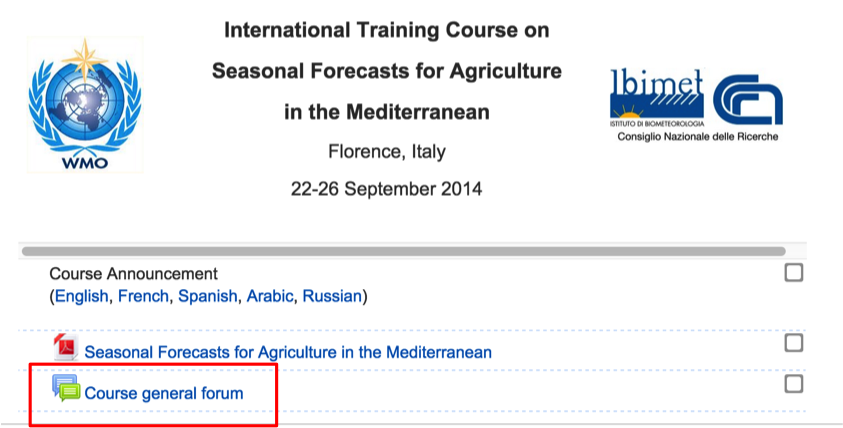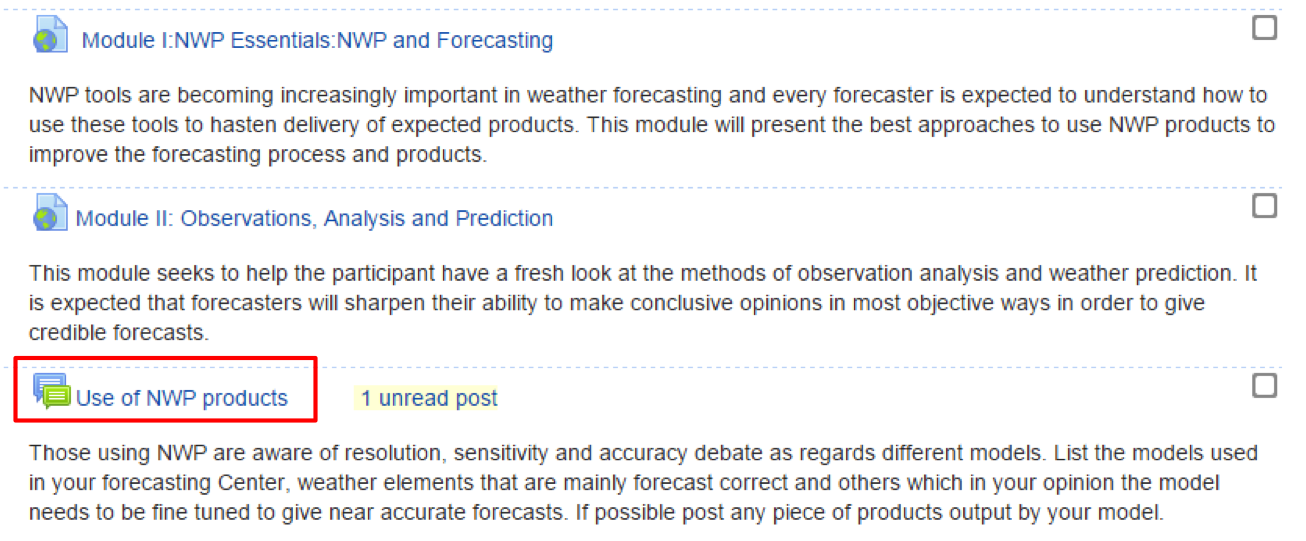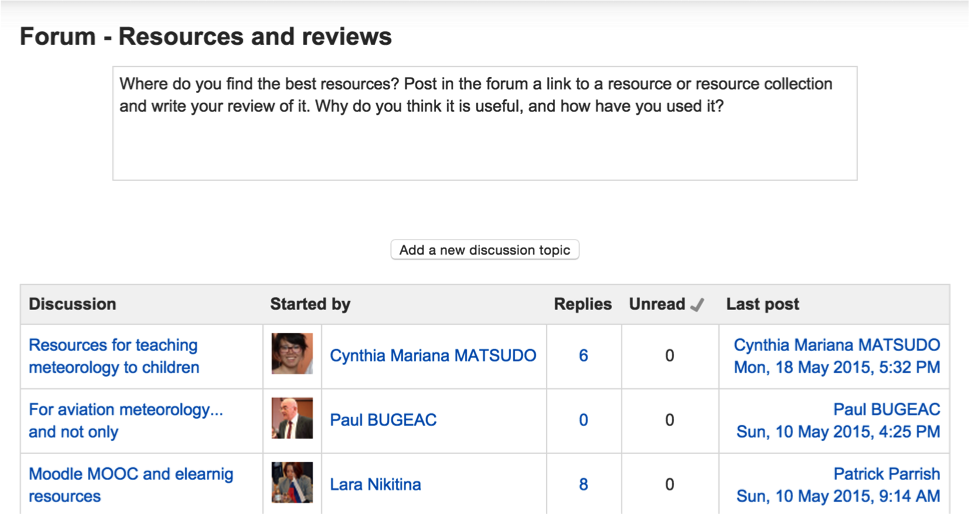Providing opportunities for dialogue and reflection
| الموقع: | WMO Education and Training Programme |
| المقرر: | Calmet Moodle Unit 3 - Provide opportunities for dialogue and reflection |
| كتاب: | Providing opportunities for dialogue and reflection |
| طبع بواسطة: | 访客用户 |
| التاريخ: | الأحد، 14 ديسمبر 2025، 3:35 PM |
الوصف
Introduction to Unit 3
1. Why dialogue and reflection are necessary for learning

Many educational theorists claim that learning cannot occur without dialogue and reflection. Reading and listening are not enough. Interaction is required.
Learners need dialogue with teachers and other learners to clarify and correct their understanding. Dialogue, or two-way communication, whether in the form of questions or sharing viewpoints, serves at least five purposes.
- It provides the critical opportunity for learners to ask questions for clarification or the deeper implications about what is being learned.
- When learners have to explain what they currently understand in spoken or written words, it makes what is being learned more concrete, and can reveal gaps in learning. The feedback received can clarify or refine learning.
- The process of putting ideas into words is itself an important form of active engagement with the content, and a way of growing knowledge (even without feedback). If you have never expressed something in your own words, you do not know it fully.
- Dialogue helps learners integrate new learning with existing knowledge. Well integrated knowledge is more readily available and more easily transferred to practical contexts.
- Dialogue brings new content into the course by drawing upon the existing and growing knowledge of learners.
Reflection about what is being learned ensures that learning is strengthened. Reflection can be thought of as internal dialogue, with many of the same benefits of clarifying and integrating knowledge. Reflection, or the internal process of fitting ideas together, occurs during outward dialogue as well, and during other forms of active use of content. Unlike dialogue, reflection can be an entirely private process, such as
- writing a learning diary
- making study notes
- thinking about reflection questions provided by the teacher and learning resources
- creating a summary presentation on a topic you have studied
- collaborating with other learners on projects related learning content
Of course, reflection occurs anytime the learner is curious enough to ponder about the lesson content, and not just in formal activities. Stimulating curiosity with an interesting question or case is a good way to stimulate reflection.
2. When to use dialogue
In Moodle, dialogue most often occurs within Discussion Forums, although Chat, Blog, and Feedback activities, as well as private messages, can also be used for similar outcomes. Collaborative work also generates useful discussion among students. However, the Discussion Forum is one of the most frequently used activities in Moodle courses, and one of the most important, so we will put emphasis on this activity here.
When should you use dialogue?
The best answer is probably frequently. Dialogue is not just for Q&A following lectures or readings, although that is a very good use. It can also be an important format for course content, not just an activity about course content. Content can sometimes be provided to learners in more engaging ways during discussion than within a lecture. For example, rather than just lecturing about the key ingredients for a convective storm, asking learners to share the most common conditions for storm initiation in their region will involved learners, stimulate what they already know, and create a broader learning experience while together you discover the key ingredients. Rather than just explaining what you see in a satellite image showing convective initiation, asking learners to share what they see first generates more active engagement. Dialogue can draw out what learners already know while they are learning new things, which makes knowledge more integrated.
At which level should you create your Discussion Forums?
In Moodle, a Discussion Forum can be created at any level within the course structure, and you might want to have forums at a variety of levels. A Course-wide forum, placed in section 0 at the top of the course page, is a good choice for inviting general discussion about the course as a whole, or about course logistics.

If you use discussion as a frequent strategy, you may also want to create individual discussion forums for each main topic, section, or week, placing it at the top of the section to indicate its topic-level intention. This will help to keep the discussions in those forums more focused and manageable for you and the participants.
At times, an individual learning activity targeting a key learning outcome might be centered on the use of a discussion activity. In these cases, a discussion forum might be created within a section, next to the learning resources that support it.

3. Forms of discussion
Discussion forums come in many sizes and shapes. The choice depends on your purposes and intended learning outcomes.
Open discussion
This simplest and most flexible format for discussion is to leave it open to evolve according to how participants want to take it. Maybe you just ask for specific questions or ask students to share their thoughts, and then see where this leads. However, this does not mean the teacher can give up responsibility. Whether or not you as teacher intend to be the primary contributor, you will still need to initiate the discussion to give it a goal (see Initiating a discussion), and to guide it to useful conclusions.
Structured discussion
Structure in a discussion can be simple or highly formal. A debate, with potentially many rules about arguments and responses, is one of the most formal structures. But many other structures are possible in Moodle Discussion forums. For example, you can require a certain number of original posts or responses from each participant, or you can restrict them as well. You can be the lead of the discussion, or you can assign responsibility to individual participants or groups to lead discussion for different topics. You might also create a discussion with a specific goal for a final, collaborative conclusion, such as a list or decision.
Structure might also be based on roles assigned to participants or the teacher. Will the teacher take on a Socratic role and drive discussion toward a predetermined solution? Will participants be assigned various roles, such as devil's advocate, summarizer, synthesizer, etc.?
The size of the discussion group can also determine its outcome. Moodle allows participants to be assigned to groups so that small group discussions can take place. These may stimulate more participation than large group discussions.
Evaluating discussions
Like all activities, discussion forums can be evaluated for the level of participation and quality of posts, and can contribute to a participant's grade in a course. This capability is discussed more in Unit 5, Design assessments.
4. Initiating a discussion
If you want to start an active classroom discussion, one of the worst ways is to give a long lecture and then simply ask, "Are there any questions?" This can put participants in the intimidating position of having to admit that they did not understand.
If teaching is an art, the art of initiating dialogue and inviting questions is at the heart of it. The invitation should be genuine, letting participants know all of their questions and comments are appreciated and valid. And the invitation should be intriguing, setting up a reason for discussion. One of the best ways is to begin with a question yourself or to state a goal for the discussion. If the Discussion Forum is a focused activity and not for general use, you may want to state this guiding question or goal in the forum Description so that it will always be visible in the interface when learners use the forum.

5. Facilitating discussion
By its nature, discussion requires freedom to contribute and share ideas without judgement. However, this does not mean that no facilitation is required.
If fact, discussions are most effective when the trainer has a clear presence, sets the proper tone and expectations, prompts students to contribute, and performs the important task of synthesizing and summarizing to ensure the discussion achieves useful outcomes.
However, good facilitation also means leaving space for dialogue to develop. A skilful trainer keeps a light touch in directing discussions to avoid inhibiting learners' freedom of thought and expression. Training sometimes means allowing time for learners to respond to each other rather than providing the answers. Remember that learning occurs through the challenge of expressing what one is learning, not just hearing what the trainer knows.
6. Encouraging reflection
How do you stimulate reflection?

Whenever you give students the space and opportunity to ponder about what they are learning you are stimulating reflection. Continuing to present new content without stopping to ask learners to think about and apply what they are learning can kill reflection. Learning without reflection is rote learning--learning for the short term, or for memorization of facts and details rather than deeper understanding and lasting utility.
Learners need challenges along the way that can tell them whether they are learning sufficiently. These challenges can take many forms, and Moodle provides ample tools to create them. Reflection is stimulated by any challenging practice activity such as Quizzes, exercises, and assignments (see Unit 4, Design opportunities for practice), but also by more explicit self-reflective activities like writing a personal Blog, responding to a Questionnaire, Survey, or Feedback activity (see Unit 6, Evaluation). Involving learners in self- and peer-assessment (see Unit 5, Design assessment), can be an especially powerful tool for encouraging reflection.
Collaborative work with teams of learners can be another great way to stimulate both dialogue and reflection. This can be done within Moodle, but is often done using other collaborative tools, such as Google Drive documents, or many other creative collaborative tools available freely online. These can be linked from Moodle Pages to keep them a part of the course.
But of course, discussion forums, the primary topic of this unit, are the most common activities for reflection by learners. Discussion are particularly good at encouraging reflection when they are free and open to the input of all learners, initiated with reflection in mind, and well-facilitated.